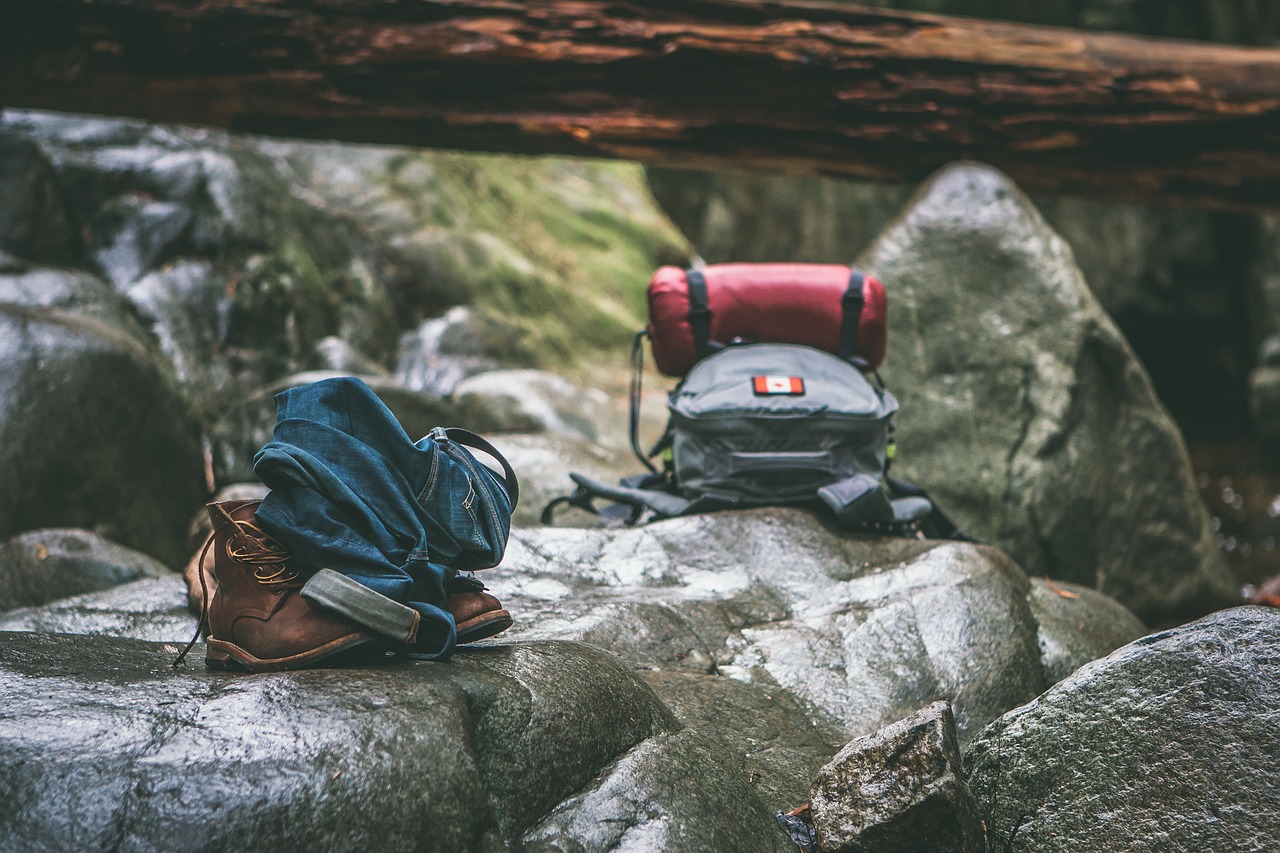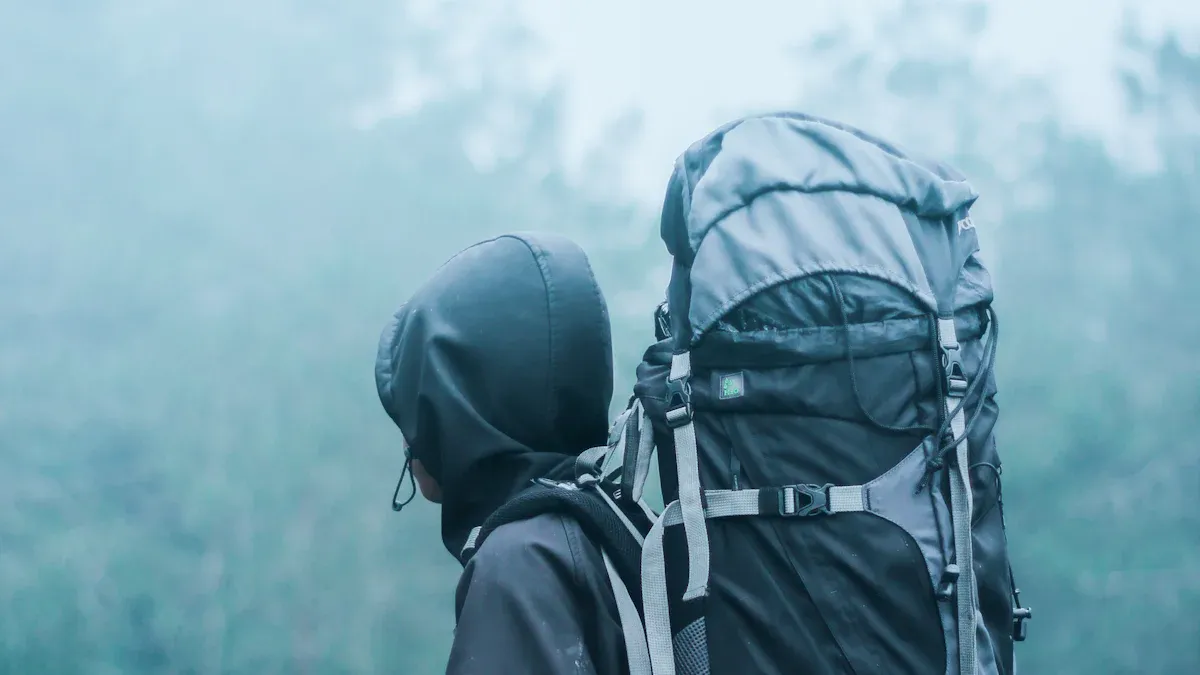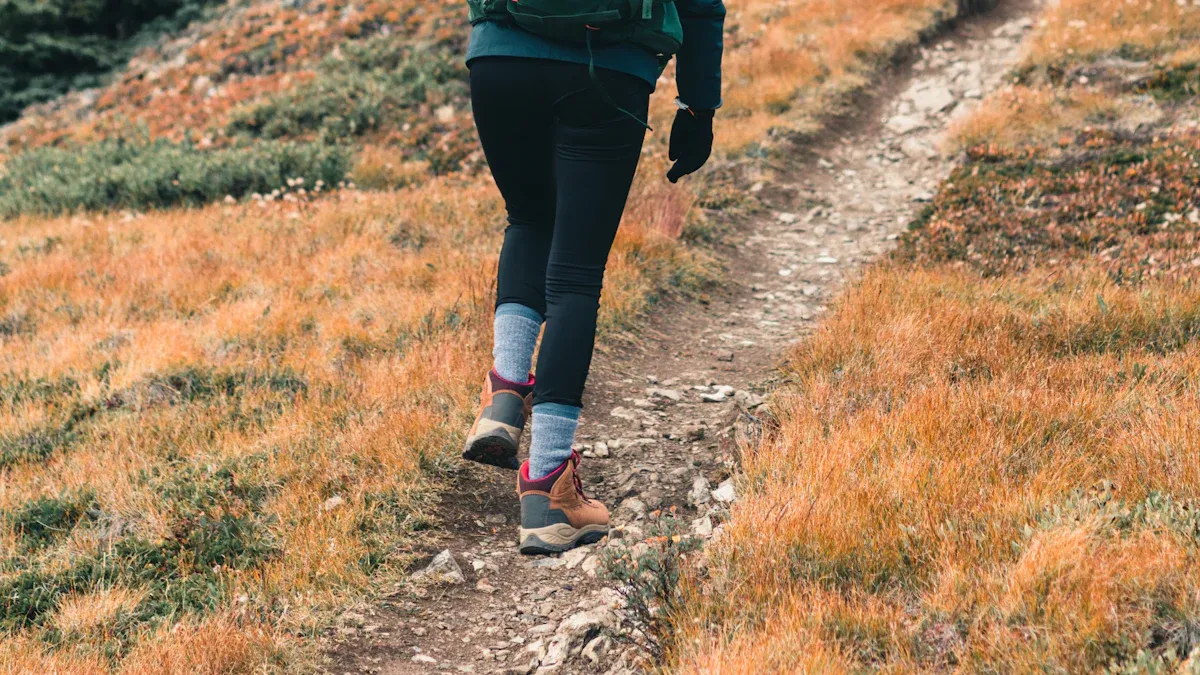
Choosing the best waterproof backpack for hiking is vital for protecting your gear in unpredictable environments. Waterproof backpacks have gained popularity as outdoor activities like hiking and camping continue to grow. Consumers increasingly demand reliable gear to shield belongings from water damage. Studies show that backpack weight influences satisfaction during hikes, highlighting the need for lightweight, ergonomic designs.
Key Features to Look For

Waterproof Materials and Sealing
When selecting the best waterproof backpack for hiking, prioritize materials designed to keep your gear dry in wet conditions. Advanced waterproof fabrics utilize specialized weaving techniques, polymer coatings, and fiber blends to enhance water resistance. Dense weave structures prevent liquid penetration, while coatings like polyurethane and silicone create hydrophobic surfaces. These technologies ensure your backpack can withstand rain, river crossings, or accidental spills.
Tip: Look for backpacks with weather-resistant zippers and reinforced stitching. These features add an extra layer of protection against water infiltration, ensuring your belongings stay safe and dry.
Comfort and Ergonomic Design
Comfort plays a crucial role in your hiking experience. Ergonomic designs, informed by biomechanics, distribute weight evenly across your shoulders, hips, and back. Features like padded shoulder straps, supportive hip belts, and lumbar pads reduce strain during long hikes. Adjustable torso lengths allow for a customized fit, ensuring the backpack aligns with your body shape.
- Key Benefits:
- Prevents discomfort caused by uneven weight distribution.
- Reduces fatigue, enabling longer hikes on challenging trails.
- Supports natural body movement, enhancing efficiency.
Breathability and Ventilation
Breathability is essential for maintaining comfort during strenuous hikes. Backpacks with ventilation systems minimize sweat buildup and improve airflow. Metrics like MVTR (Moisture Vapor Transmission Rate) and CFM (Cubic Feet per Minute) measure the effectiveness of these systems. Testing in controlled environments has shown that airflow significantly impacts breathability, keeping you cool and comfortable.
Note: Backpacks with mesh panels or suspended back systems often provide superior ventilation, making them ideal for hot and humid conditions.
Adjustability and Straps
Adjustable straps ensure a precise fit, enhancing comfort and weight distribution. Features like adjustable torso lengths and customizable shoulder straps allow you to carry the load closer to your hips, reducing strain on your back. This is particularly important when carrying heavy loads of 25 pounds or more.
- Advantages of Adjustable Straps:
- Improves balance and stability during hikes.
- Prevents pressure points and discomfort.
- Accommodates different body shapes for a tailored fit.
Weather Protection Features
Weather protection features go beyond waterproof materials. Look for backpacks with integrated rain covers, sealed seams, and durable coatings. These additions provide extra security against harsh weather conditions. High-tech fabrics, combined with reinforced stitching, ensure durability while maintaining lightweight construction.
| Feature | Description | Impact on Hiking |
|---|---|---|
| Integrated Rain Cover | Protects the backpack from heavy rain and snow. | Keeps gear dry in extreme conditions. |
| Sealed Seams | Prevents water from seeping through stitching. | Enhances overall waterproofing. |
| Durable Coatings | Adds strength and water resistance to the fabric. | Extends the lifespan of the backpack. |
Additional Considerations
Durability and Longevity
When investing in a hiking backpack, durability should be a top priority. A well-constructed backpack can withstand rugged trails, heavy loads, and exposure to harsh elements. Look for materials like ripstop nylon or high-denier polyester, which resist tears and abrasions. Reinforced stitching and bar-tack reinforcements at stress points add extra strength, ensuring the backpack holds up under pressure.
Tip: Check for backpacks with double-layered bottoms. This feature prevents wear and tear when placing your bag on rough surfaces, extending its lifespan.
Durability also depends on the quality of zippers and buckles. Opt for brands that use YKK zippers or Duraflex buckles, as these components are known for their reliability. A durable backpack not only protects your gear but also saves you money in the long run by reducing the need for frequent replacements.
Sustainability and Eco-Friendly Options
As environmental concerns grow, many hikers are choosing eco-friendly gear. Sustainable backpacks use recycled materials, such as post-consumer plastics or upcycled fabrics, to reduce waste. Some brands also adopt eco-conscious manufacturing processes, minimizing water usage and carbon emissions.
Look for certifications like Bluesign® or GRS (Global Recycled Standard) to ensure the backpack meets environmental standards. These certifications guarantee that the product was made with minimal environmental impact.
Note: Choosing an eco-friendly backpack doesn’t mean compromising on quality. Many sustainable options are just as durable and functional as traditional designs.
By selecting a sustainable backpack, you contribute to preserving the natural landscapes you love to explore. It’s a small step that makes a big difference.
Cost and Budget-Friendly Choices
Finding a high-quality waterproof backpack doesn’t have to break the bank. Many affordable options offer excellent features, making them suitable for both beginners and seasoned hikers. When shopping on a budget, focus on essential features like waterproof materials, comfortable straps, and adequate storage capacity.
- Budget-Friendly Tips:
- Compare prices across multiple retailers to find the best deal.
- Look for sales or discounts during off-season periods.
- Consider lesser-known brands that offer competitive features at a lower price.
While cost is important, avoid compromising on critical aspects like durability and comfort. A cheap hiking backpack may save you money upfront, but it could cost more in the long term if it fails during a hike. Striking a balance between affordability and quality ensures you get the best value for your investment.
Extra Features (e.g., hydration compartments, external loops)
Extra features can enhance your hiking experience by adding convenience and functionality. Hydration compartments, for example, allow you to carry water bladders, making it easier to stay hydrated without stopping. External loops and daisy chains provide attachment points for gear like trekking poles, sleeping bags, or carabiners.
Some backpacks also include built-in organizers, making it easier to keep your gear accessible and tidy. Compression straps help secure your load, preventing items from shifting during movement.
| Feature | Benefit | Ideal For |
|---|---|---|
| Hydration Compartments | Easy access to water while hiking. | Long-distance hikes. |
| External Loops | Convenient attachment points for bulky gear. | Multi-day trips or technical hikes. |
| Compression Straps | Keeps the load stable and compact. | Uneven or challenging terrains. |
Pro Tip: If you plan to hike in low-light conditions, consider a backpack with reflective accents or an integrated light loop for added safety.
By choosing a backpack with the right extra features, you can tailor it to meet your specific hiking needs. This ensures a more enjoyable and efficient outdoor adventure.
Tips for Packing Your Backpack

Organizing the Main Compartment
Efficiently organizing the main compartment of your backpack ensures easy access to essential items during your hike. Place heavier items, such as water bottles or cooking gear, close to your back. This positioning improves balance and reduces strain on your shoulders. Store lighter items, like clothing or sleeping bags, at the bottom or top of the compartment.
Use packing cubes or dry bags to separate gear into categories. For example, keep food in one bag and clothing in another. This method not only keeps your backpack tidy but also protects items from moisture. Avoid overpacking the main compartment, as this can make it difficult to retrieve specific items quickly.
Pro Tip: Roll your clothes instead of folding them. This technique saves space and minimizes wrinkles.
Utilizing Pockets and Compartments
Pockets and compartments enhance organization and accessibility. Use external pockets for items you may need frequently, such as snacks, maps, or a rain jacket. Internal compartments are ideal for securing valuables like keys or wallets.
The design of your backpack can significantly impact how you utilize these features. For instance:
| Backpack Model | Features | Benefits |
|---|---|---|
| Hyperlite Daybreak | Small internal pocket for valuables | Keeps important items secure and organized. |
| Osprey Talon | Mesh internal pocket for keys, wallet, etc. | Prevents loss of small items within larger compartments. |
| General Design | External pockets for quick access to items like headlamps or rain jackets | Enhances convenience by allowing quick retrieval of essential gear during hikes. |
Strategically using these compartments ensures you spend less time rummaging through your bag and more time enjoying your hike.
Adjusting Straps for Weight Distribution
Properly adjusting your backpack straps is crucial for maintaining comfort and stability. Start by tightening the hip belt so it rests snugly on your hips. This step transfers most of the weight to your lower body, reducing strain on your shoulders. Next, adjust the shoulder straps to pull the backpack closer to your back.
Use load-lifter straps to fine-tune the weight distribution. These straps, located at the top of the shoulder straps, help shift the load forward or backward. Finally, secure the sternum strap across your chest to stabilize the backpack and prevent it from swaying.
Note: Regularly check and readjust your straps during the hike, especially if you feel discomfort or notice uneven weight distribution.
By following these tips, you can pack your backpack efficiently and comfortably, ensuring a more enjoyable hiking experience.
Choosing the right hiking backpack involves balancing size, weight, materials, and comfort. A well-fitted pack with durable construction and weather protection ensures your gear stays safe and dry. Consider your hiking needs, such as trip length and budget, to find the ideal option. Brands like Bilibag offer reliable waterproof day hiking backpacks tailored for outdoor enthusiasts.
| Key Factor | Description |
|---|---|
| Size | Larger packs suit extended trips; smaller ones work for day hikes. |
| Weight | Lightweight packs enhance mobility; heavier ones provide better support for bulky loads. |
| Materials | Polyester resists water well; nylon offers superior durability. |
| Weather Protection | DWR coatings and rain covers shield gear from wet conditions. |
| Breathability | Ventilated designs reduce sweat buildup for added comfort. |
| Fit and Adjustability | Adjustable straps and torso lengths accommodate various body shapes. |
| Durability | High-denier fabrics withstand wear and tear over time. |
| Comfort | Proper weight distribution minimizes strain during long hikes. |
| Cost | Affordable options balance essential features with budget constraints. |
| Storage Options | Organized compartments improve accessibility and gear management. |
Tip: Prioritize backpacks that align with your hiking style and terrain to maximize comfort and efficiency.
